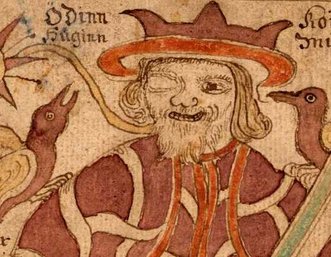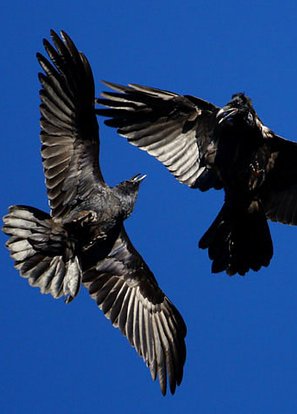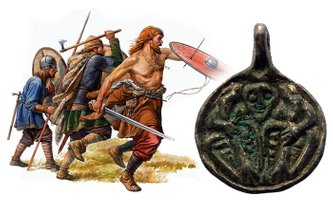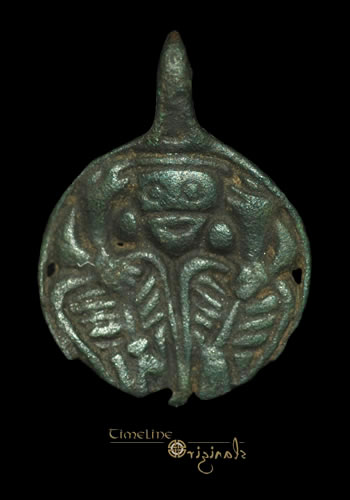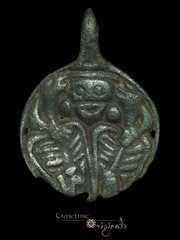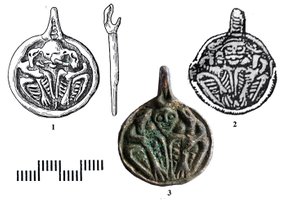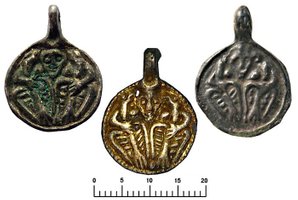Odin with Huginn and Muninn
Huginn and Muninn sit on Odin's shoulders in an illustration from an 18th century Icelandic manuscript
In Norse mythology, Huginn (from Old Norse "thought" and Muninn (Old Norse "memory" or "mind") are a pair of ravens that fly all over the world, Midgard, and bring the god Odin information. Huginn and Muninn are attested in the Poetic Edda, compiled in the 13th century from earlier traditional sources; the Prose Edda and Heimskringla, written in the 13th century by Snorri Sturluson; in the Third Grammatical Treatise, compiled in the 13th century by Óláfr Þórðarson; and in the poetry of skalds. The names of the ravens are sometimes modernly anglicized as Hugin and Munin.
In the Poetic Edda, a disguised Odin expresses that he fears that they may not return from their daily flights. The Prose Edda explains that Odin is referred to as "raven-god" due to his association with Huginn and Muninn. In the Prose Edda and the Third Grammatical Treatise, the two ravens are described as perching on Odin's shoulders. Heimskringla details that Odin gave Huginn and Muninn the ability to speak.
Migration Period golden bracteates, Vendel era helmet plates, a pair of identical Germanic Iron Age bird-shaped brooches, Viking Age objects depicting a moustached man wearing a helmet, and a portion of the 10th or 11th century Thorwald's Cross may depict Odin with one of the ravens. Huginn and Muninn's role as Odin's messengers has been linked to shamanic practices, the Norse raven banner, general raven symbolism among the Germanic peoples, and the Norse concepts of the fylgja and the hamingja.
Is their intelligence a coincidence.. ? Have they learned it from us, or we just from them......?
Link to amazing facts about ravens
Due to their intelligence, ravens are very playful. They prank with the wolves. Once a raven headed towards a sleeping wolf and pinched it by its tail. When the wolf dashed to bite the raven, the bird jumped out. When the wolf approached tiptoe to the raven, the bird let it approach till 30 cm and flew away, landing a few meters of the wolf's back and repeating the prank.
Video on the intelligence of raven
Another reference can be found in : Pagan zoomorphic pendants ancient Russia 10 -14 centuries." V.E.Korshun. Vol.#3
see figures: M4 - M16
They come from: 1) the Kurgan group Sednief near Chernigov province and county; 2) Gnezdovo treasure 1868 .; 3) village Cornflowers Vladimir province; 4) City Tags (Gotland, Sweden), burial 762; 5) Segisty, coming Barva, Zedermanland, Sweden, burial; 6) The town of Prenzlau, Northern Germany. Somehow, this list does not hit the suspension of the mounds in the Mykolaiv Belogorsoy desert (now the village Gornali) Sudzhansky region Kursk region, found during excavations DY Samokvasov more in 1872 (3). More significant finding looks like pendants in the Vitebsk region, made in 2009. It should be noted that the appendage is made of silver and coated with gold.
Well. I could have been with these stones until after dark, but as my wife wanted to travel on.. well.. I see you again, some day, hogback stones from Gosforth. And if you happen to be there one day, do not forget that monument on the outside...
Further on with the Cumbrian hogbacktour !
In - yes, luckily again in - St. Peter's church in Heysham, there is a truly beautiful hogback stone. The guide told us, it had been studyied by Thor Ewing, a writer, in 2000. in 'Understanding the Heysham hogback' A tenth century sculpted stone monument and its context (link), Thor Ewing tells in detail what he dicovered on the both sides of this hogback stone.
Just being brought in the church as late as the 1970's accompanied with some protest here and there among the church visitors, considered as being a token of old paganism, it had been remarkably nice preserved, and a lot of detail can be seen, still. Truly worthwile a visit.
I had a small debate with the guide in the church if the - zoomorphic, in my opinion - faces on the sides were lions (or hippo's). The guide doubted if the vikings could have known about lions. Well I guess so, concerning the runes on the Ancient Greek lion statue at the Arsenal, Venice. For example. Vikings did travel south..
But when he told me he was doubting the vikings 'discovered' (as the native inhabitants were of course, in the first place) America before Columbus, I decided to rest my case..
One has to know when to start and to end a conversation ..
Just discovered the book in a bookstore written by Geoff Holder - The guide to the mysterious Lake District, I knew there had to be another hogback stone in Lowther, St. Micheal's Church. With a promising image described in the text of 'a naval and a land-based force of shield-bearing vikings above a fish and what might be a coiled sea serpent. On the reverse is a row of female figures with snakes, possibly a representation of the hideous hag Hel'. Wow. If that did not sound as a true pagan promised land ..
Not complaing too much after all we have seen, this visit was the dissapointing one of them all. But if you wife states 'I am happy to have seen them' and I am answering 'Measuring is knowing' and the even more obligate verb 'handling 'if we did not see it at all, we wouldn't have known anything at all of how they were looking' the glass was again half full, at the last day of our journey..
The hogback stone appeared to be just being tolerated within the entrance segment part of the church. As something you never use anymore but you do not throw away - entirely. That sort of feeling emerged when seeing this hogback asylum seekers.. Bed, bath and bread, ás we say in Dutch, but no luxury at all and standing on some outcuts of wood, you would balance the table with at home..
Come on, St. Micheal's Church.. care a bit more of your 'children' !
This hogback stone was moved in the church in 1907. Hogback stones layed partially buried in the churchyard before it was dug up and moved into the church.
The promising depiction of a longship - as certainly can be seen after some studying - see http://vikingminds.co.uk/pages/longship
we have missed !
The stone itself is (157 x 50 x 30 cm) and very worn.
The hogback stones in Cumbria - very diverse in quality, but everyone worth a visit ! Especially on a gloomy day in late October ...
The churches to visit - see photos of resp. St. Andrew's church in Penrith, St. Mary's church in Gosforth, St. Peter's church in Heysham and St. Micheal's church in Lowther.
Did I miss out on another one in Cumbria ? Let me know !
In a next blog I will take you to four - still remaining utterly mysterious- statues 'guarding' the graveyard of St. Andrew's church in Dacre..
For the last blog of October 9th see this link.
References: (as always, links to where the books can be ordered are attached).
Edwards, B.J.N. Vikings in North West England - The artifacts (1998);
Emery, Gordon, CURIOUS CUMBRIA, The Lake District & Beyond: A celebration of Cumbria (2023)
Ewing, T. 'Understanding the Heysham hogback' A tenth century sculpted stone monument and its context ;
Hall, R. Viking Age archaeology in Britain and Ireland (first printed 1990, reprinted with amendments in 1995);
Holder, G. The guide to the mysterious Lake District (2009)
possibly also (as there within the part of Cumbria dealing with Carlisle, the Eden Valley, Barrow-in-Furness, Whitehaven and the west coast is being dealed with)
Holder, G. Paranormal Cumbria (2010)
http://vikingminds.co.uk/pages/longship
Odin with two birds pendant
Excessively Rare Viking 'Odin' Bronze Pendant
Copper alloy, 1.17 grams, 22.93 mm. Circa 10th century AD. A small round disc pendant depicting the gruesome image of Odin peering out from between two skeletal birds, Hugin and Munin (Thought and Memory), his arms around the necks and he’s clutching them by the breast. The bodies of both birds appear to be representing shields, this could symbolize Odin taking the bodies of men fallen in battle. Odin was also called All-father because he was father of all gods, he was also known as Valfather (father of the slain) because all who fell in battle became his adopted sons. An excessively rare item in very fine condition. Ex old European collection.
See publication also in Minerva Magazine - The International Review of Ancient Art & Archaeology of november/december 2011
p. 21, item 7:
http://minervamagazine.co.uk/archive_pdfs/2011_Vol_22_06.pdf
An interesting reference to this kind of pendants can be found here:
http://www.kulturologia.ru/blogs/180813/18704/
Also take a look at the example found in England:
